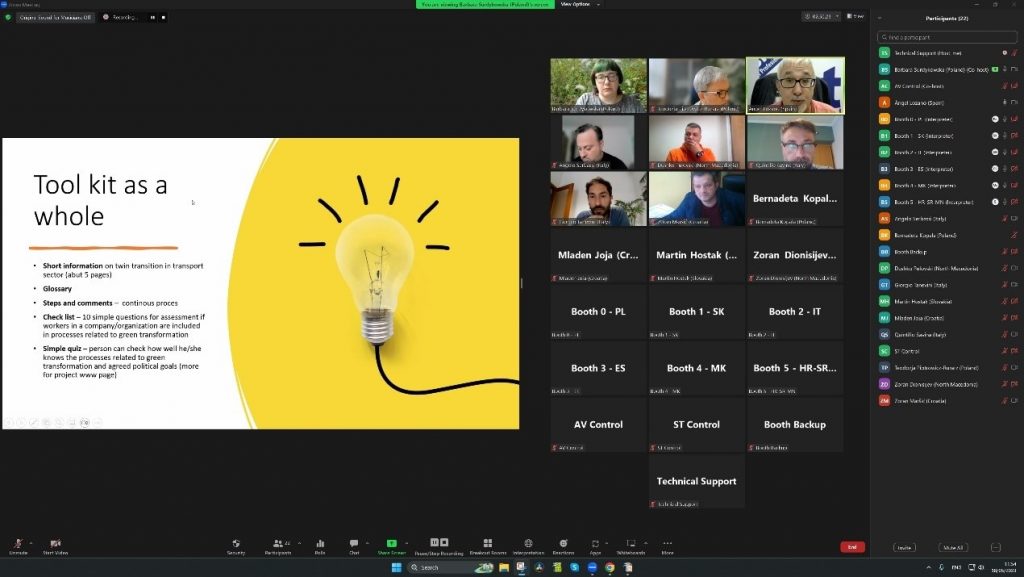NEWS
Workshop 18 May 2023
During the meeting, the tool kit was discussed. The general structure of the tool kit was adopted, consisting of the following elements, presented by Barbara Surdykowska.
• Short information on twin transition in transport sector (abut 5 pages)
• Glossary
• Steps and comments – continous proces
• Check list – 10 simple questions for assessment if workers in a company/organization are included in processes related to green transformation
• Simple quiz – person can check how well he/she knows the processes related to green transformation and agreed political goals (more for project www page)
The expert indicated that, in her opinion, for the purposes of the tool kit, it is best to use the term “twin transition”. Twin transition refers to the interplay between digital and green transitions: If properly used and managed, digital technologies can help economies become (more) resource efficient, circular and climate neutral. A twin transition approach recognizes that there is a huge and largely untapped opportunity for technology and data to drive sustainability goals. Rather than treating digital and sustainability in isolation, a twin transition strategy combines these critical functions to unlock huge benefits in terms of efficiency and productivity. The twin transition can make a positive impact by ‘greening’ technology, data assets and infrastructures while accelerating sustainability across the organization.
Reported use of ICT for environmental sustainability:
• Facilitate remote work
• Reduce business travel
• Use fewer materials, equipment or consumables
• Produce less waste
• Use less energy
• Virtualise products or services
• Recycle equipment or products
• Measure our environmental impacts
• Adopt eco-design principles
• Offer sustainable transport alternatives
The following process (individual steps) cannot be undertaken at one time – it is about the continuous flow of information and the continuous undertaking of discussions and consultations.
First of all, it should be emphasized that this type of information and consultation process around the twin transition is NOT intended to and can NOT replace the information and consultation (negotiation) processes that exist in the legal system (in the industrial relations system). For example, the process is not intended to replace information/consultation/negotiation processes related to collective layoffs/transition of the workplace to a new employer/existing process related to labor participation in the area of health and safety etc.
Step one
• Identify the factors that will affect the company in the near and medium term. You should try to isolate the factors that connect to the twin transition
• Legislative changes (at the national level, at the EU level
• The need to implement new technological processes (resulting from already existing legislative changes concerning, for example, certain standards that must be implemented within a certain time)
• Problems with recruitment of employees (shortages of workers)
• Perceived evolution of the needs and behaviour of consumers who are recipients of the service offered by a given company
• Perceived evolution of needs and expectations on the part of existing contractors
• Increase in energy prices
• Unstable macroeconomic situation
• High inflation
Step two
• The parties should jointly try to define in what time perspective the identified factors will affect the enterprise and how deep their impact on working conditions will be
Step three
• The parties should jointly try to define what actions should be taken resulting from the impact of factors defined as important and related to the twin transition on the working conditions of employees
• Joint exploration/ preparation/ creation of trust
• Joint mapping/ regular assessment/ opportunities and challenges
• Joint overview of situation and adoption of strategies for twin transition
• Adoption of appropriate measures
• Regular joint monitoring, follow up, learning , evaluation
In the discussion, the meeting participants stressed that the aspect of showing good practices must be more visible. It was also pointed out that it should be emphasized that the process of information and consultation can take place at different levels (the need to highlight the role of European Works Councils was pointed out). Participants in the discussion stressed that the value of information and consultation needs to be more emphasized, and that the presentation presented was overly focused on the consumer/contractor of transportation services. The labor aspect needs to be more prominent.
A participant from North Macedonia stressed that older workers have limited opportunities to learn and assimilate new digital skills and that this should be taken into account.
A participant from Italy pointed out the need to identify specific solutions to inform and consult employees.

Funded by the European Union. Views and opinions expressed are however those of the author(s) only and do not necessarily reflect those of the European Union. Neither the European Union nor the granting authority can be held responsible for them.
